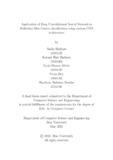| dc.contributor.advisor | Ashraf, Faisal Bin | |
| dc.contributor.author | Shafique, Nadia | |
| dc.contributor.author | Shaheen, Kaynat Bint | |
| dc.contributor.author | Sikder, Zarjis Husain | |
| dc.contributor.author | Dey, Utsho | |
| dc.contributor.author | Swacha, Sharforaz Rahman | |
| dc.date.accessioned | 2023-12-07T06:10:44Z | |
| dc.date.available | 2023-12-07T06:10:44Z | |
| dc.date.copyright | 2023 | |
| dc.date.issued | 2023-05 | |
| dc.identifier.other | ID 18201138 | |
| dc.identifier.other | ID 19101408 | |
| dc.identifier.other | ID 19101630 | |
| dc.identifier.other | ID 19301042 | |
| dc.identifier.other | ID 23141040 | |
| dc.identifier.uri | http://hdl.handle.net/10361/21934 | |
| dc.description | This thesis is submitted in partial fulfillment of the requirements for the degree of Bachelor of Science in Computer Science, 2023. | en_US |
| dc.description | Cataloged from PDF version of thesis. | |
| dc.description | Includes bibliographical references (pages 56-59). | |
| dc.description.abstract | Skin diseases represent a significant global health concern, and prompt and pre-
cise diagnosis is necessary for efficient treatment. Convolutional Neural Networks
(CNNs), in particular, have shown tremendous promise in the diagnosis of skin dis-
eases due to their capacity for processing and learning from complex patterns in
visual data. Employing 28x28 RGB images taken from the HAM10000 dataset, the
purpose of this work is to develop and assess a customized CNN model created
exclusively to aid in the classification of different skin conditions. This method al-
lows the model to efficiently learn the distinctive characteristics of each type. Our
model is evaluated using a number of metrics, such as accuracy, precision, recall,
and F1-score. We have also compared our results to well-known pre-trained models
like ResNet50 and EfficientNetB0/B2. In comparison to existing pre-trained mod-
els, our own model performs better due to its increased test accuracy, reduced test
loss, and computational parameters. Additionally, it has fewer trainable parame-
ters as well as a shorter training time per epoch, which makes it appropriate for
deployment in situations with constrained computational resources. In conclusion,
Our model promises to improve diagnostic accuracy, perhaps enabling earlier and
more effective methods for diseases of the skin because of its higher performance
and computational advantages. | en_US |
| dc.description.statementofresponsibility | Nadia Shafique | |
| dc.description.statementofresponsibility | Kaynat Bint Shaheen | |
| dc.description.statementofresponsibility | Zarjis Husain Sikder | |
| dc.description.statementofresponsibility | Utsho Dey | |
| dc.description.statementofresponsibility | Sharforaz Rahman Swacha | |
| dc.format.extent | 59 pages | |
| dc.language.iso | en | en_US |
| dc.publisher | Brac University | en_US |
| dc.rights | Brac University theses are protected by copyright. They may be viewed from this source for any purpose, but reproduction or distribution in any format is prohibited without written permission. | |
| dc.subject | Skin cancer | en_US |
| dc.subject | CNN model | en_US |
| dc.subject | BKL | en_US |
| dc.subject | Convolution layer | en_US |
| dc.subject | Accuracy | en_US |
| dc.subject | AUC | en_US |
| dc.subject | MEL | en_US |
| dc.subject | BCC | en_US |
| dc.subject | AKIEC | en_US |
| dc.subject | Deep learning | en_US |
| dc.subject | Dermoscopic data | en_US |
| dc.subject | Convolutional Neural Network | en_US |
| dc.subject | NV DF | en_US |
| dc.subject | ROC curve | en_US |
| dc.subject | F1 score | en_US |
| dc.subject | VASC | en_US |
| dc.subject.lcsh | Machine learning | |
| dc.subject.lcsh | Cognitive learning theory | |
| dc.subject.lcsh | Neural networks (Computer science) | |
| dc.title | Application of deep convolutional neural network in multiclass skin cancer classification using custom CNN architecture | en_US |
| dc.type | Thesis | en_US |
| dc.contributor.department | Department of Computer Science and Engineering, Brac University | |
| dc.description.degree | B.Sc. in Computer Science and Engineering | |

